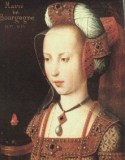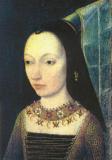27 MARCH 1482
 Death of Mary of Burgundy, stepdaughter of Margaret of York (sister of Edward IV and Richard III). More information on Mary here.
Death of Mary of Burgundy, stepdaughter of Margaret of York (sister of Edward IV and Richard III). More information on Mary here.
Tags: Burgundy, Margaret of Burgundy
 Margaret of York, sister of Edward IV and Richard III, leaves London on her journey to Burgundy to marry Charles the Bold, Duke of Burgundy. Edward IV allies himself with Burgundy and Brittany against Louis XI of France (the ‘Spider King’).
Margaret of York, sister of Edward IV and Richard III, leaves London on her journey to Burgundy to marry Charles the Bold, Duke of Burgundy. Edward IV allies himself with Burgundy and Brittany against Louis XI of France (the ‘Spider King’).
Tags: Margaret of Burgundy
 Death of Mary of Burgundy, stepdaughter of Margaret of York (sister of Edward IV and Richard III). More information on Mary here.
Death of Mary of Burgundy, stepdaughter of Margaret of York (sister of Edward IV and Richard III). More information on Mary here.
Tags: Burgundy, Margaret of Burgundy
On 5 January 1477, Charles the Bold of Burgundy died at a battle while laying siege to Nancy in Lorraine. His heiress was his daughter Mary from his second marriage to Isabella of Bourbon. After her death in 1465, he married on 3 July 1468 Margaret of York, sister of Edward IV and Richard III. Margaret would after his death become Mary’s most constant advisor.
More on Charles the Bold on Encyclopaedia Britannica.
Tags: Battles, Margaret of Burgundy
 Margaret of York, Duchess of Burgundy, dies at Malines. She was a sister of Edward IV and Richard III. After Richard’s death she supported the Yorkist pretenders. She was on very good terms with her husband’s daughter and her family and had a successful and positive influence on Burgundian politics. She was a patron of William Caxton, who introduced the printing press to England.
Margaret of York, Duchess of Burgundy, dies at Malines. She was a sister of Edward IV and Richard III. After Richard’s death she supported the Yorkist pretenders. She was on very good terms with her husband’s daughter and her family and had a successful and positive influence on Burgundian politics. She was a patron of William Caxton, who introduced the printing press to England.
Tags: Books, Margaret of Burgundy
Christine Weightman, Margaret of York: The Diabolical Duchess. Amberley Publishing, 2009. ISBN 978 1 84868 099 9 (paperback)
This review was first presented at the 2012 NSW Convention in Mittagong.
The book deals with the life and times of Margaret of York, from her childhood to her death in 1503.
The aim of the book as stated by the author, is the examination of Margaret’s political activity, motivation and lifestyle. It is also a study of how a woman living in the second half of the fifteenth century could ensure her personal survival and prosperity.
The survival of many accounts of Margaret’s marriage to Charles, Duke of Burgundy, shows that it was a dazzling affair, dubbed “the marriage of the century.” John Paston reported that he had seen nothing like it; there had not been such splendour since the court of King Arthur. On her marriage to Charles the Bold she became the wife of one of the wealthiest rulers of Europe and lived among the riches and pageantry of the Burgundian court.
Margaret was a bibliophile, a more discerning collector than anyone else in her family, and gave books as presents to family and friends. She had access to the ducal library – Charles himself, had a strong interest in the Classics, but twenty-five books have been identified as being Margaret’s. She was also a patron of William Caxton.
While the primary reason for marriage to Charles was to provide an heir for Burgundy, none eventuated. Charles assured Margaret of his affection, and unlike someone else I could name, he did not try to divorce her, let alone chop off her head. However, Margaret formed a mutually affectionate bond with her step-daughter Mary. After the latter’s untimely death, Margaret worked closely with Mary’s widower, Archduke Maximilian, and was quite involved in the lives of her step-grandchildren.
Margaret lived in tumultuous times. Within a decade of her marriage, she was widowed, when Duke Charles was killed in 1477 during the siege of Nancy. Thrown on her own resources, Margaret was to survive riots, rebellions, plots and counter-plots and political wheeling and dealing – and she was also a key player in politics. This aspect of the book could be a complex and confusing subject but the author makes it intelligible and interesting.
In terms of personality, Margaret is revealed as intelligent, resourceful, persuasive and a good businesswoman. The failure of her brother King Edward to pay the balance of her dowry was the play on her mind all her life and she was unstinting in her attempts to protect, and regain her dower lands. The usurpation of the throne by Henry Tudor saw her lose her profitable trading privileges.
That Tudor had taken the throne with French help, set off alarm bells in Burgundy, particularly when Henry failed to renew the Anglo-Burgundian alliance. Maximilian would have preferred a Yorkist heir on the throne, indebted to Burgundy, and Weightman contends that Margaret would have given the Archduke her wholehearted support in any attempt to overthrow Henry. Nevertheless Margaret’s motivation for supporting first Lambert Simnel and then Perkin Warbeck are obscure. Family feeling, politics, or both? Weightman mentions that the Archduke and his son had a better claim to the throne than Henry, being directly descended from John of Gaunt and his first wife, Blanche.
Margaret was vilified by Tudor historians, who claim that her attempts to overthrow Henry as part of her “malicious and obsessive vendetta against him.” Polydore Vergil for example, claims that Margaret pursued Henry with insatiable hatred and with “fiery wrath.” Edward Hall referred to her as a spider. Weightman states that the source of these opinions was Henry himself, who wrote to Gilbert Talbot in 1494 of the “great malice the Lady Margaret of Burgundy beareth continually against us…”
In conclusion, I can recommend this book because it brings Margaret to life in her own right, rather than her being brief mentions in other people’s stories. It shows her participation as a player in the politics of late fifteenth-century Burgundy and England, and her resilience in surviving all the upheavals that came her way. This book is readable and an example of what good biographical writing can achieve in bringing to light a medieval life.
Tags: Books, Margaret of Burgundy
 Margaret (3 May 1446 – 23 November 1503) was the sister of Edward IV and Richard III. She married Charles the Bold, duke of Burgundy, in 1468. He died on 5 January 1477 and the dowager duchess remained influential in Burgundian politics until the end of her life.
Margaret (3 May 1446 – 23 November 1503) was the sister of Edward IV and Richard III. She married Charles the Bold, duke of Burgundy, in 1468. He died on 5 January 1477 and the dowager duchess remained influential in Burgundian politics until the end of her life.
Did Margaret like Chocolate? Hardly, chocolate hadn’t been introduced to Europe during her lifetime. A pity really, as today Belgian chocolates are world famous and as Duchess of Burgundy, Margaret would have been right on the spot.
Chocolate was only introduced into Europe after Hernan Cortes saw the Aztecs drink the beverage during his visit around 1519. In Belgium, chocolate was only produced on a large scale in the 19th century and what comes to mind when we hear the term ‘Belgian chocolates’ was only developed in the early 20th century. Read the rest of this entry »
Tags: Margaret of Burgundy